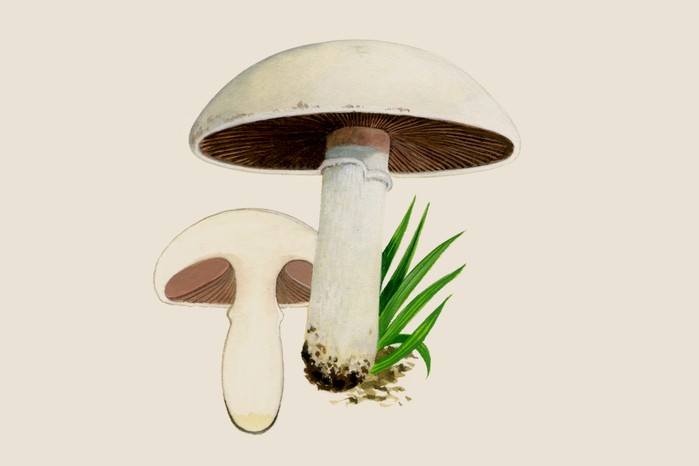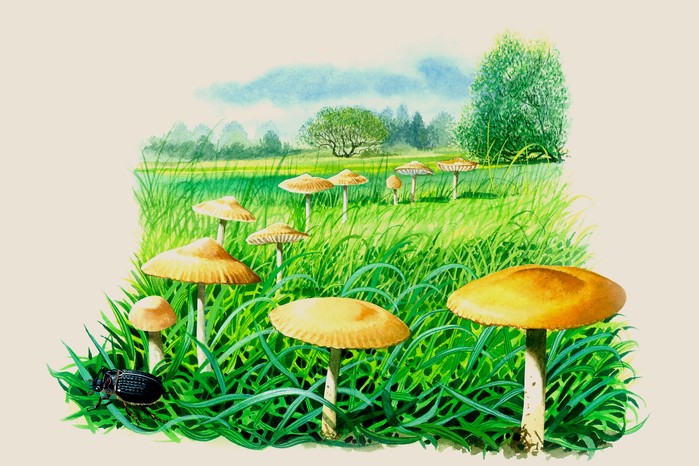It is a "toadstool". A conical head is not to be eaten - or so I was told as a child. They are the ones the garden gnomes sit on and laugh at the "big people".. so the fungi are not a pest - just the gnomes who move things around the garage/workshop and hide them where you knew they should not be! - They are just having fun. And the gnomes do look nice when you spot them sitting in the sun and chuckling.... Gnomes are harmless. Not what you can say about the toadstools! (Incidentally, no-one has ever reported seeing a Toad using one as a stool... - That is just a myth! - Believe it or not.).
"Pass me some more of that Magic Mushroom soup please..."
K2
P.S. Extracted from Gardeners World...
For most of the year fungi are present as string-like mycelium, which usually lives underground. Usually all we see only the fruiting bodies, known as mushrooms, which cast spores into the air to colonise new spaces. Mushrooms come in a variety of beautiful shapes and sizes.
The British Isles are home to a phenomenal 15,000 species of fungi and wild mushrooms, found in a range of habitats but most often in woodlands, fields and grassland – you may be
lucky enough to find some growing in your own garden.
Mushrooms growing in the garden are usually a good thing, living among healthy soil and decomposing wood and other organic matter, such as leaf litter. They are part of a healthy ecosystem and provide food for a range of species including squirrels and beetles. Common types of fungi include fairy ring fungus (
Marasmius oreades), which grows in lawns and causes no damage.
The main thing when finding fungi in the garden for the first time, is to not panic. Remember that most fungi is good and a natural, and healthy part of the ecosystem. Take time to identify which species you have and enjoy seeing which species come along to eat it.
Never eat a mushroom that you can't confidently identify.
Field mushroom (Agaricus campestris)
Field mushroom (
Agaricus campestris)
Cap: 4-10cm across, convex, domed, expands slowly, smooth white to start, scales peel as it ages. (Rounded).
Stem: short and white, narrows at base.
Ring: thin.
Gills: pink to start, turning chocolate brown to deep black.
Edibility: edible.
Fairy ring mushroom (Marasmius oreades)
Fairy ring mushroom (
Marasmius oreades)
Cap: 2-5cm across, pale brown convex dome, becoming floppy, with edges wrinkled or grooved.
Stem: narrow.
Gills: whitish. Occurs in large, gradually expanding rings in lawns.
Edibility: edible, but can be confused with other, poisonous, species. Fairies are not know to dance around poisonous varieties... At least I've not read of any sightings...
Honey Fungus - Destructive to gardens.
Honey fungus can wreak havoc in gardens. Named after its honey-coloured mushrooms, which sometimes appear in late summer and autumn, it comprises several species in the
Armillaria genus, which spread underground and attack and kill the roots of woody and perennial plants.
Most woody and herbaceous perennials are at risk from honey fungus, including birch, hydrangea, privet, apple, pear, magnolia and beech. Roses, flowering currant, willow and viburnum seem particularly vulnerable.
But this may be your fungus... Note the more conical shape of the head...
Destroying angel (Amanita virosa)
Beautiful but dangerous. Destroying angel can be found in mixed broadleaf and birch woodland.
Credit: Blickwinkel / Alamy Stock Photo
A pure white, deadly poisonous mushroom. Apparently, just a piece of destroying angel in a soup made from otherwise edible species is enough to kill everyone who eats the soup.
Where: broadleaved and mixed woodland, especially birch woodland. It grows on the ground.
When: July to November.
Symptoms: contains deadly amatoxin poisons. Effects are seen eight to 24 hours after ingestion and include vomiting, diarrhoea, and severe stomach pains. There may be a deceiving period of improvement before the second effects of liver and kidney poisoning occur.
I may be wrong, because I am in no way a mushroom expert!
But don't eat it... I have had these on my lawn, but the domed type, and those may be edible. - But I won't risk it! - The largest I recorded was 12inches across! Usually appear the season after I have been shredding wood on the lawn, so the sawdust is their natural "food". I have also had some lovely fairy rings, but not (yet) spotted the fairies at night dancing in the moonlight...
D.S.






















![DreamPlan Home Design and Landscaping Software Free for Windows [PC Download]](https://m.media-amazon.com/images/I/51kvZH2dVLL._SL500_.jpg)


















































